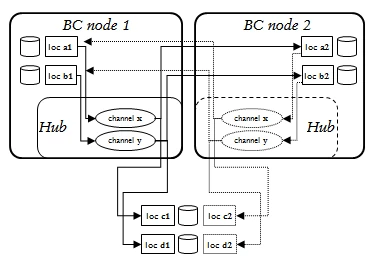Hvrfailover
Ingres, Unix & Linux
Command hvrfailover applies only to Ingres locations.
Name
hvrfailover - Failover between Business Continuity nodes using replication
Synopsis
hvrfailover [-r] [-v] start
hvrfailover [-r] [-v] stop
hvrfailover boot
hvrfailover check
Description
Hvrfailover manages the 'failover' of a database service between two nodes. These are called 'Business Continuity (BC) nodes'. They do not need to share a disk. At any moment only one of these BC nodes is active, and HVR is replicating database changes across to the other node, so that if an error occurs on the active node then hvrfailover can switch-over to a 'virtual IP address'. At this point existing database connections are broken (an error message will be returned immediately or they may have to timeout first) and new database connections are sent to the other node instead. This ensures 'high availability' for the database service, and means a replicated system has no 'single point of failure'. Each BC node contains one or more replicated databases plus a HVR hub with channels to replicate changes from them to the other BC node.
It is important to distinguish between 'graceful failover' and 'abrupt failover'. Graceful failover is when a proper 'stop' was performed on the first node (so that all replicated changes are flushed to the other node) before switching to the virtual IP address and starting on the other node. In this case, the first node is still consistent and a 'failback' is possible without causing consistency problems. Abrupt failover is when a proper stop was not performed (machine crashed?) or did not fully complete (network timeout?). In this case there could be unreplicated changes left in the first node (called 'phantom changes'), so a 'failback' to it is impossible because it could give database inconsistency. Resetting a database after an abrupt failover typically requires an Hvrrefresh and a new Hvrinit. The unreplicated changes are lost.

The replication inside the hvrfailover nodes must conform to the diagram on the right. The arrows show the direction of replication; the dotted arrows are replication after failover has occurred. The names of the hub database and channels are identical in both nodes. All locations in one BC node must end with suffix 1 and in the other with suffix 2. Channels in one node must capture changes from one location inside that node and integrate them to one on the other node.
So for example if a channel named mychannel in the hub database on the first BC node capture location is xxx1 and an integrate location xxx2, then channel mychannel also exists in other BC node with capture location xxx2 and integrate location xxx1.
Channels may also integrate changes to extra databases outside either BC nodes. This can be used to add an off-site 'disaster recovery' database to the channel for a 'one-way' switch-over after a real emergency, with the two BC nodes providing bi-directional switch-over to maintain business continuity for smaller failures or during batchwork. These databases must be added with a different location name in each hub; with suffix 1 in the first node's hub and with suffix 2 in the other hub.
Command hvrfailover start first checks that the other BC node is not active by doing a ping of virtual IP address (unless option -r is supplied) and Hvrtestlistener to the other hub's scheduler (unless option -v is supplied). It then begins replication to the other node by starting the HVR Scheduler. Finally (if option -r is not supplied), it activates the virtual IP address, so new database connections will be redirected to databases on this node. Option -r therefore means that replication should be started, but database connections via the virtual IP address should not be affected. Option -v means that only the virtual IP address is started or stopped. Command hvrfailover start should never be done on one node while either replication or the virtual IP address is active on the other node.
Command hvrfailover stop breaks all connections into the local databases by stopping and starting the DBMS communication server (e.g. ingstop/start -iigcc, not if -v is supplied), and deactivating the virtual IP address (not if -r is supplied). It also attempts to flush replication so that both databases are identical.
Configuration Options
File $HVR_CONFIG/files/hvrfailover.opt contains the following options:
| Parameter | Description |
|---|---|
| -env=NAME=VALUE | Environment variables. Set e.g. $II_SYSTEM and $HVR_PUBLIC_PORT. |
| -hubdb=dbname | Hub database name. Should be the same name on both BC nodes. Mandatory. |
| -virtual_ip=ipaddress | Virtual IP address. |
Configuring Hvrfailover
Configure the DBMS (Ingres) so it is restarted at boot time on both nodes.
Configure the hvrfailover.opt file in $HVR_CONFIG/files. This file should be identical on both BC nodes.
Example:-hubdb=hvrhub -virtual_ip=192.168.10.228 -env=II_SYSTEM=/opt/Ingres/IngresII -env=HVR_PUBLIC_PORT=50010Create a new interface for the virtual IP address on both BC nodes. This can be done, as root or by copying an interface file into directory /etc/sysconfig/network-scripts.
Example:$ cp ifcfg-eth0 ifcfg-eth0:1Then edit this file and change the directives:
DEVICE=eth0:1 #(for this example) IPADDR=<virtual ip> ONBOOT=no USERCTL=yesConfigure Hvrremotelistener and Hvrfailover so they are restarted at boot time by adding a line to /etc/hvrtab on both nodes.
Example:root 4343 /opt/hvr/hvr_home /opt/hvr/hvr_config -EHVR_TMP=/tmp ingres hvrfailover /opt/hvr/hvr_home /opt/hvr/hvr_config -EHVR_TMP=/tmpConfigure Hvrmaint to run frequently, for example by adding a line to crontab.
Optionally a crontab may be added to run Hvrlogrelease on both BC nodes. Hvrlogrelease option (-logrelease_expire) should be used to ignore logrelease files older than a certain period. This is necessary to ensure Hvrlogrelease cleans up redo/journal files on the BC nodes.
Files
